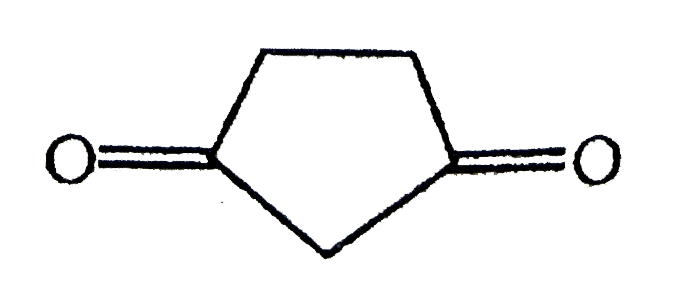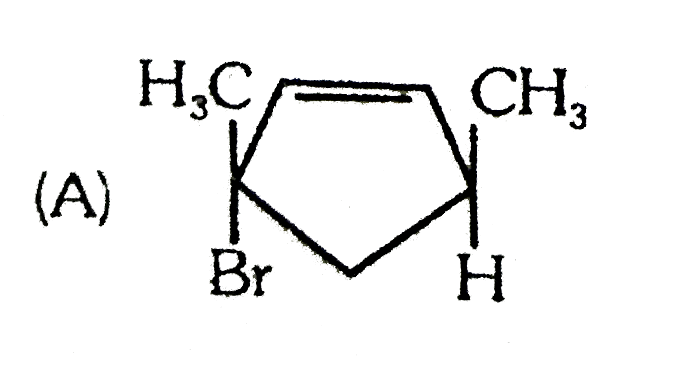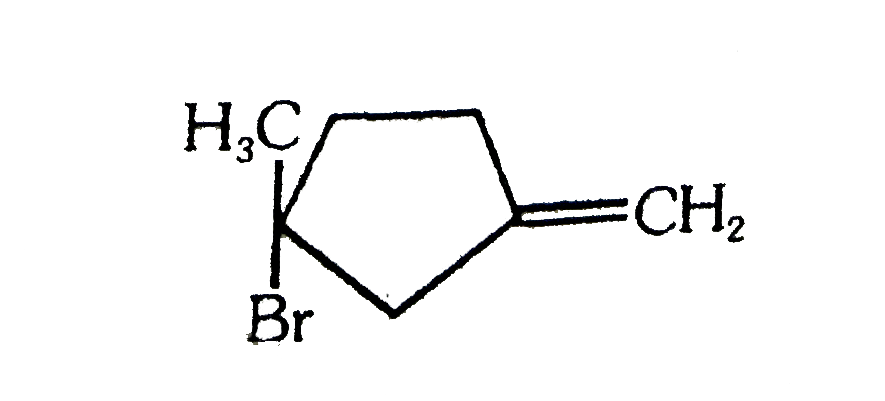An alkyl halide with molecular formula C4H9Br is optically active. What is its structure ?
To determine the structure of an alkyl halide with the molecular formula C₄H₉Br that is optically active, we need to follow these steps:
Step 1: Identify the Molecular Formula
The molecular formula given is C₄H₉Br. This indicates that the compound contains 4 carbon atoms, 9 hydrogen atoms, and 1 bromine atom.
Hint: The number of hydrogen atoms suggests that the compound is likely to be a branched alkyl halide rather than a straight-chain alkyl halide.
Step 2: Draw Possible Structures
We can start by drawing the possible structural isomers of C₄H₉Br. The main types of isomers we can consider are:
1. Straight-chain isomers
2. Branched isomers
1. Straight-chain isomer:
- Butyl bromide (1-bromobutane): CH₃-CH₂-CH₂-CH₂Br
2. Branched isomers:
- 2-bromobutane: CH₃-CH(CH₃)-CH₂Br
- 1-bromo-2-methylpropane: CH₃-CH(CH₃)-CH₂Br
Hint: Consider the connectivity of carbon atoms and the position of the bromine atom in the structure.
Step 3: Determine Optical Activity
For a compound to be optically active, it must have a chiral center. A carbon atom is chiral if it is bonded to four different substituents.
- 1-bromobutane: The terminal carbon (C1) is bonded to two hydrogens, making it non-chiral.
- 2-bromobutane: The second carbon (C2) is bonded to:
- CH₃ (methyl group)
- CH₂Br (bromomethyl group)
- CH₂ (methylene group)
- H (hydrogen)
Since all four substituents on C2 are different, 2-bromobutane is optically active.
- 1-bromo-2-methylpropane: The carbon with bromine does not have four different substituents, hence it is not optically active.
Hint: Look for a carbon atom that has four different groups attached to it to confirm optical activity.
Step 4: Conclusion
The structure of the alkyl halide C₄H₉Br that is optically active is 2-bromobutane, which can be represented as:
CH₃∣∣CH₃−CH−CH₂−Br∣∣H
Summary
The optically active structure of the alkyl halide with the molecular formula C₄H₉Br is 2-bromobutane.
The molecular formula given is C₄H₉Br. This indicates that the compound contains 4 carbon atoms, 9 hydrogen atoms, and 1 bromine atom.
We can start by drawing the possible structural isomers of C₄H₉Br. The main types of isomers we can consider are:
1. Straight-chain isomers
2. Branched isomers
- Butyl bromide (1-bromobutane): CH₃-CH₂-CH₂-CH₂Br
- 2-bromobutane: CH₃-CH(CH₃)-CH₂Br
- 1-bromo-2-methylpropane: CH₃-CH(CH₃)-CH₂Br
For a compound to be optically active, it must have a chiral center. A carbon atom is chiral if it is bonded to four different substituents.
- 2-bromobutane: The second carbon (C2) is bonded to:
- CH₃ (methyl group)
- CH₂Br (bromomethyl group)
- CH₂ (methylene group)
- H (hydrogen)
The structure of the alkyl halide C₄H₉Br that is optically active is 2-bromobutane, which can be represented as:
The optically active structure of the alkyl halide with the molecular formula C₄H₉Br is 2-bromobutane.
Topper's Solved these Questions
- BOOK - MODERN PUBLICATIONCHAPTER - HALOALKANES AND HALOARENESEXERCISE - NCERT In-text Questions9videos
HALOALKANES AND HALOARENES
- BOOK - MODERN PUBLICATIONCHAPTER - HALOALKANES AND HALOARENESEXERCISE - NCERT Textbooks Exercises1videos
HALOALKANES AND HALOARENES
- BOOK - MODERN PUBLICATIONCHAPTER - HALOALKANES AND HALOARENESEXERCISE - PRACTICE PROBLEMS30videos
HALOALKANES AND HALOARENES
- BOOK - MODERN PUBLICATIONCHAPTER - GENERAL PRINCIPLES AND PROCESSES OF ISOLATION OF ELEMENTSEXERCISE - COMPETION FILE (Integer Type Numerical Value Type Questions)5videos
GENERAL PRINCIPLES AND PROCESSES OF ISOLATION OF ELEMENTS
- BOOK - MODERN PUBLICATIONCHAPTER - ORGANIC COMPOUNDS CONTAINING NITROGEN EXERCISE - UNIT PRACTICE TEST5videos
ORGANIC COMPOUNDS CONTAINING NITROGEN
Similar Questions
Knowledge Check
- Question 1 - Select One
An organic halide with formula C6H13Br on heating with alc. KOH gives two isomeric alkene (A) and (B) with formula C6H12. On reductive ozonolysis of mixture (A) and (B) ,the following compounds are obtained :
CH3COCH3,CH3CHO,CH3CH2CHO and (CH3)2CHCHO
The organic halide is :A2-bromohexaneB3-bromo-2-methylpentaneC2, 2-dimethyl-1-bromobutaneD2-bromo-2, 3-dimethylbutane - Question 2 - Select One
How many alkyl groups having the molecular formula C4H9- are possible?
A4B3C2D5 - Question 3 - Select One
An optically active compound A (assume dextrorotatory) has the molecular formula C7H11Br. A reacts with hydrogen bromide, in the absence of peroxides to yield isomeric products, B and C, with the molecular formula C7H12Br2. Compound B is optically active, C is not. Treating B with 1 mol of potassium butoxide yields (+)−A. Treating C with 1 mol of potassium tert-butoxide yields (±)−A. Treating A with potassium tert-butoxide yields D(C7H10). Subjecting 1 mol of D to ozonolysis followed by treatement with zinc and acetic acid yields 2 moles of formaldehyde and 1 mole of 1,3-cyclopentanedione.

The optically active compound 'A' isA B
B C
C D
D
An acid of molecular formula, C5H10O2 is optically active. What is its structure?
View SolutionA carboxylic acid of the formula, C3H5O2Br is optically active. What is its structure?
View SolutionOn ozonolysis a hydrocarbon of molecular formula C4H6 gives succinin acid only. What is the structure of hydrocarbon ?
View SolutionHow many alkyl groups having the molecular formula C4H9- are possible?
View SolutionNumber of isomers of molecular formula C2H2Br. Is :
View Solution

